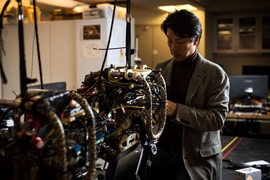Engineer and physicist Deblina Sarkar has been appointed as an assistant professor and AT&T Career Development Chair Professor in the Media Arts and Sciences program at the MIT Media Lab. Her research group, Nano-Cybernetic Biotrek, is a novel interdisciplinary effort, bringing together engineering, applied physics, and biology with two distinct goals: first, to develop disruptive technologies for ultra-low power nanoelectronic computation; and second, to merge such next-generation technologies with living matter to create new paradigms for life-machine symbiosis.
Sarkar earned her PhD in nanoelectronics, and then made what she calls a “drastic decision” to shift from electrical engineering to neuroscience. “During the last year of my PhD I realized that I wanted to diversify — the brain was on my mind, as was physics.” She applied for postdocs and research positions all over the country, but couldn’t find a good fit until she learned about Ed Boyden’s Synthetic Neurobiology group. “Most said it would be too challenging. Ed’s response was unique. I told him my background was totally different to what he does, but that I wanted to learn and could bring fresh ideas. Ed wrote back in five minutes saying sure, let’s talk.”
Postdoc work with Boyden followed, during which time Sarkar applied her knowledge of physics and engineering to develop technology that achieves super-resolution mapping of the brain’s building blocks using a conventional optical microscope with biomolecular retention, allowing users to decipher the nanoscale structure of biomolecules not otherwise accessible with existing technologies.
“First as a graduate student, and then as a postdoc at MIT, Deblina demonstrated the fantastic ability to develop new technologies that confront major problems. She fuses together interdisciplinary thinking about biology, health, physics, and devices in a new way,” says Boyden. “I'm excited about her future work, which will boldly stitch together these disciplines to result in new technologies that change how living systems interface to machines.”
The freedom to think in enterprising and unusual ways about fields with little historic overlap excited Sarkar, and contributed to her decision to continue her work at the Media Lab. Above all, she wanted her group’s mission to encompass a sense of adventure. And the name, Nano-Cybernetic Biotrek? She knows it’s a mouthful, but it was important to Sarkar that the name capture the spirit of what she’s trying to do.
“If I had gone to a different department in a different school, my group would definitely have a more boring name,” she laughs. “Here, I felt I had ample room for creativity. If I break down the group name: nano, of course, because we are building nanoscale devices. Cybernetic, the case of my group, means to use technology to control either inanimate computing systems or biological systems or their hybrids. Bio stands for biology. Trek, because the goal of the group is to set foot into untraversed territories of science — it’s an adventure.”
So, how does one conduct research in Nano-Cybernetic Biotrek? What does a project look like? Current research projects include developing nanoelectronic transistors using meta-materials to achieve extreme energy efficiency and computing performance; creating next-generation nanomachines that can effectively camouflage and trick the body into thinking that it is its own part, causing a paradigm shift in life-machine synergism; building nanoantennae that can non-invasively and remotely monitor and modulate biological systems; nanoscale mapping of bio-molecular building blocks of the brain; and ultra-sensitive electrical biosensors for point-of-care applications.
“The thing is, biology and nature, they have optimized certain things really well. In my postdoc research, I showed how the arrangement of biomolecules in the brain influences the way information is processed,” says Sarkar. “With biology, the difficulty is that it doesn’t provide us with the opportunity to build something from scratch. We’re limited by what nature has built already, which has been optimized for a certain function, which is not necessarily what we want. In contrast, the versatility of electronics is that they can be built from scratch to perform functions beyond the capabilities of biology. Our long-term goal is to achieve seamless integration of nanoelectronics into our biological systems to incorporate functionalities not otherwise enabled by biology — thus transcending existing biological limitations.”
The group starts each research project with feasibility studies, then performs more-rigorous calculations to create simulations to arrive at a robust design. Then the design is brought to nanofab to build the experimental infrastructure.
Sarkar looks for students and researchers who are excited about contributing to the adventurous and interdisciplinary ethos of the group. “My students and postdocs all have very different backgrounds: materials science, electrical, mechanical, and biological engineering. The main thing I look for in my group members is, whatever research they did previously, they are strong in their fundamentals. I believe someone who has done extremely well in their own field can also come to a new field and contribute. None of my students are doing exactly what they did in their undergrad. They contribute their expertise to new types of projects. I believe that someone who is enthusiastic and passionate can excel in any field!”










